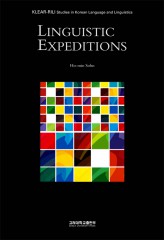Linguistic Expeditions
ISBN-13: 978-89-7641-836-0
Hardcover: 506 pages
Language: English
Sohn is a linguist of great versatility, who has done extensive work in two fields of areal linguistics: (i) Korean and Japanese, and (ii) Micronesian languages (Ulithian, Woleaian, Kwara’ae, and others). To the languages in both of these groups he has applied methods and theories of phonological, morphological, syntactic, semantic, and historical-comparative analysis. Not only does he cover these various “bread-and-butter” areas with equal skill, but he also manifests an adept approach to sociolinguistic issues and matters of language pedagogy. In treating various comparative problems, he further shows sensitive understanding of semantic and pragmatic values in English.
By and large Sohn’s work will be of general appeal both to theoretical linguists and to non-theory-oriented students of Korean (or to some extent Japanese), because “most analyses and accompanying discussions are predominantly data-based, without extensive involvement in the matters of abstract theoretical polemics.”
– Lewis S. Josephs.
This unique and intriguing collection of papers was initially published in 1986 by Hanshin Publishing Company in Korea. It brings together twenty-five articles, representing the scholarly activity of the author from the early 1970s to the mid 1980s. A remarkable feature of Sohn’s scholarship during this period is its striking breadth. Topics covered include the design of writing systems, comparative-historical linguistics, syntax, semantics, pragmatics, sociolinguistics and language pedagogy. Even more remarkable is the range of languages on which Sohn worked during this period. In addition to Korean, for which he was already becoming a leading scholar, he worked on three Oceanic languages-Kwara’ae, a language of the Solomon Islands; Ulithian, spoken on the Ulithi atoll in the Federated States of Micronesia; and Woleaian, another language of the Federated States of Micronesia. (The book’s title alludes in part to the author’s fieldwork-related travels in the Pacific.)
There is much here to capture the interest of researchers in the twenty-first century. For instance, the chapter on ‘case incorporation in English verbs’ deals with a phenomenon that is now once again at the forefront of attention in syntactic theory, making Sohn’s early comparative treatment of its properties in English and Korean highly topical. Another example involves the very insightful chapter on how best to romanize Korean-a long standing problem that has led to many proposals over the years, including a controversial new ‘official system’ promulgated by the Korean government. Sohn’s observations and experiments pinpoint the challenges associated with writing one language in the orthography of another, and offer very interesting insights into how this might best be achieved in the case of Korean.
Linguistic Expeditions is not just of historical interest. The papers that it contains, many of which would otherwise be inaccessible to researchers, are of fundamental importance to modern scholarship. This includes not only Sohn’s early work on Korean, especially its verbal system, its system of honorifics, and its ways of expressing power and solidarity, but also his pioneering work on Oceanic languages, which continues to serve as an important foundation for work in that area.
— Reviewed by William O’Grady (University of Hawai’i at Manoa)
